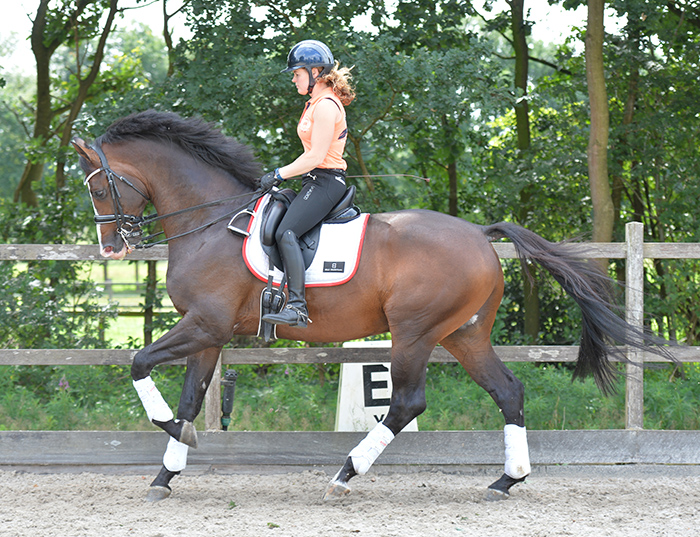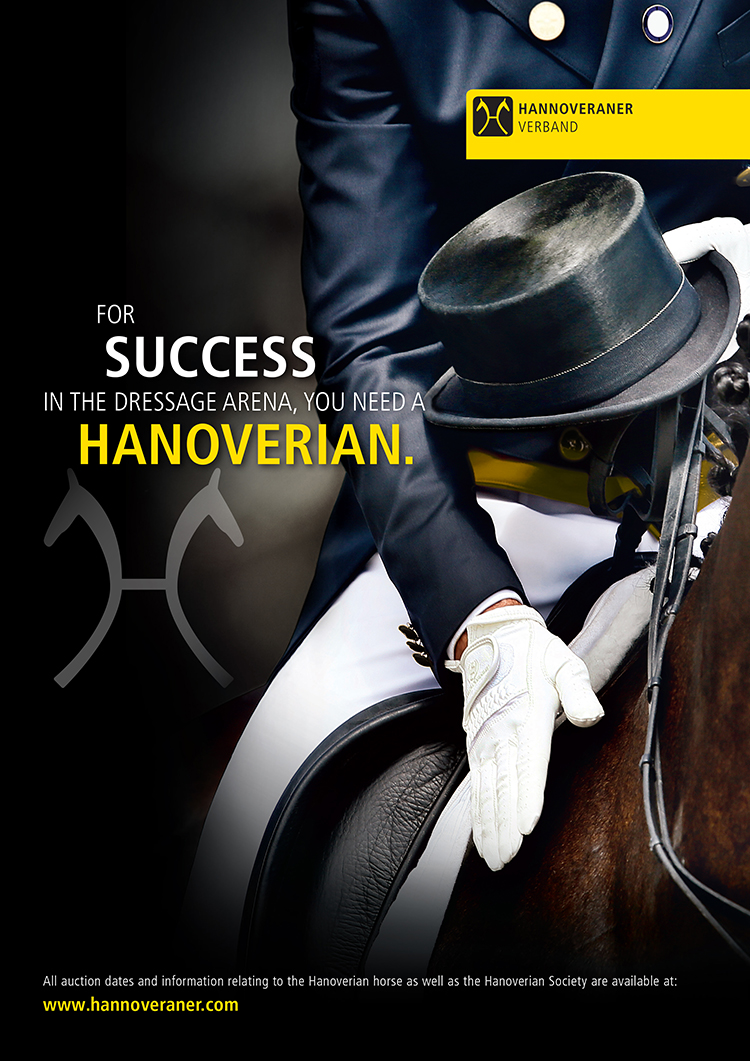Ferrero has just competed in his first Grand Prix at the age of eleven, but we look back to when he was seven years old, training with Jennifer Sekreve and Johan Hamminga…
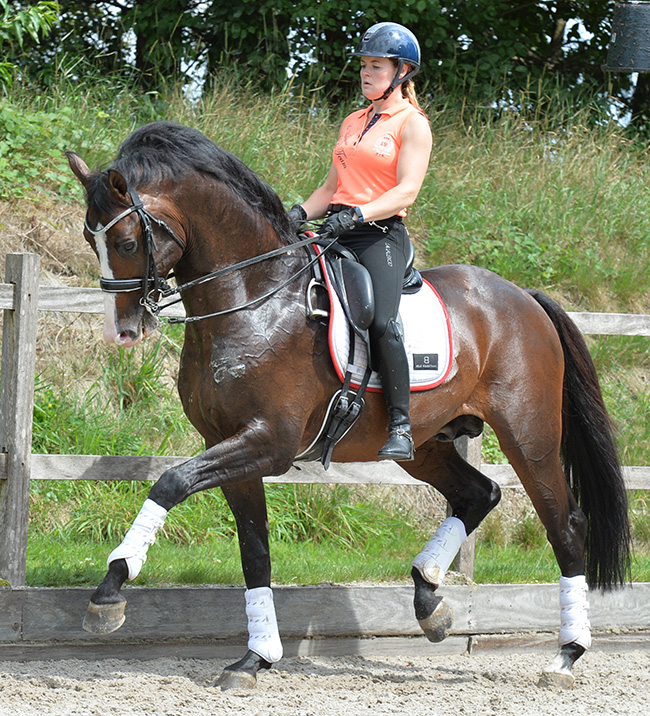
Ferrero is by Rhodium out of an Olivi / Frühling / Caritas mare, it’s a famous mare line that has produced stallions like Dutch Boy and Grand Prix competitors like Vivaldi and Cabochon. Last year he competed in the Seven-Year-old class at the World Young Dressage Horse championships, he is now competing in the class before the Prix St Georges, with a St Georges start later in the year planned.
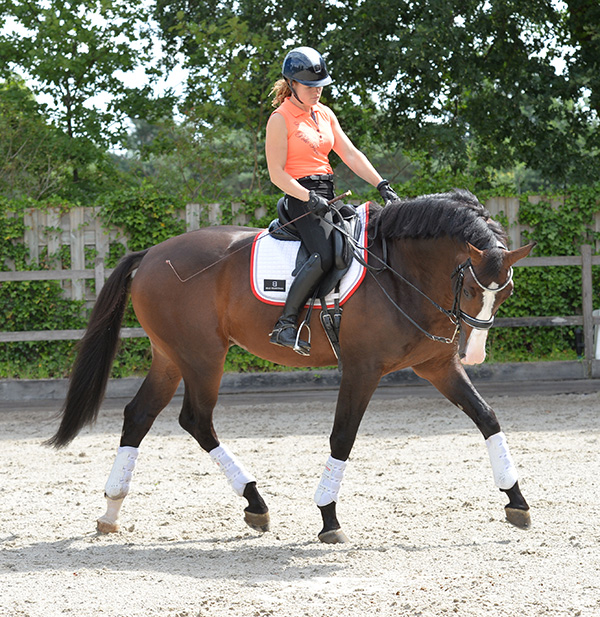
Johan comments:
Here you see that the neck is in a horizontal position, out of the wither. When you start the training session in walk and in trot, you have to prepare, so that your horse is forward and on your legs, he is listening to your leg aids, to your rein aids. You have to warm up because he is going to use his muscles in an intensive way and you need some bending to train the horse that all the muscles are available and prepared for the higher exercises.
Johan explains: “Today is Monday, he wasn’t worked yesterday, so he is a little stiff. We will give him more canter work, longer and deeper, until the feeling is okay in the seat and the contact.”
“Okay, now he is more supple and elastic, he can carry more weight and can collect a little. The horse has to learn to have more suspension, more bending in the hock and the knee. We use the transitions to make him more supple in the loins, in the croup, in the hindlegs. It is very important when the neck falls down that his nose is vertical so he can use his topline in a correct way. Now we see a more supple topline, and more fluency in the strides. This is so important, many trainers and riders say when the neck is down, the horse will be supple in the back – no, there are many lower positions where there is no contact, then the horse is not over the back, it is not working the loins and the hindlegs.”
Story continues below the advertisement
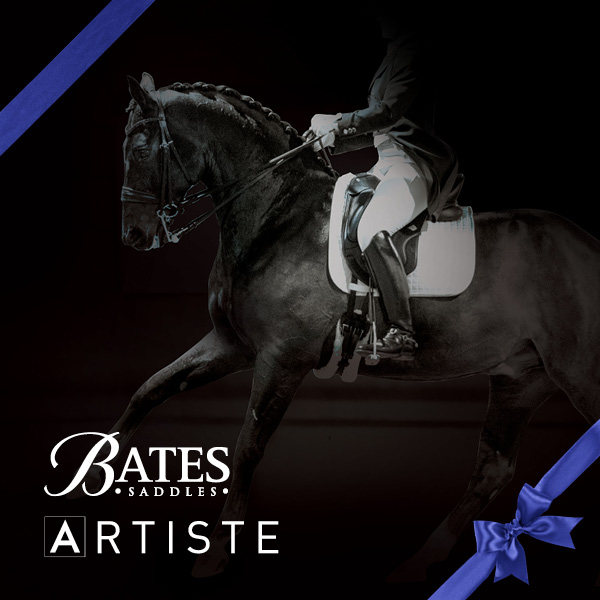
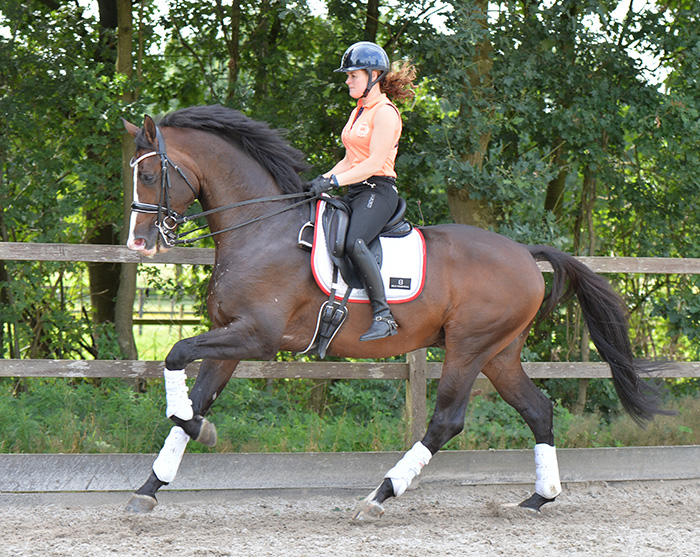
Johan comments:
That is a typical photograph showing the horse with a really good forward tendency, with an uphill tendency. That’s the neck in the right position, the poll the highest point, the nose a little bit in front of the vertical, open in the gullet. Looking to his legs, his left hind leg is first on the ground by a few centimetres in front of the right front leg. That is what we are training for, and Jen is riding without stirrups. Every day she rides one or two horses without stirrups – you try to find your balance better and better and better, so that you can sit very easily and independently.
“For a horse to be really good over the back, you need connection to both reins, and a forward tendency from behind. Two things test how the horse is over the back – enough bending behind, and smooth contact on both reins, then the back can stretch upwards. If you don’t do that, then you are on the wrong track.”
“The most important gait to show if the horse is supple in the top line is the walk. Looking at the walk, is it four beat, with overtrack, and regularity, the suppleness of the back, the neck out of the wither and horizontal, the whole body is marching. That is a sign of good riding.”
Johan comments:
This is in a real balance, nice and uphill in the neck, fine in the ear and the eye. The horse is in a horizontal balance. It’s good to see when a horse is in this balance, then you can build it up to a more collected balance. As a trainer you must always look to the ears and the eyes, when the horse looks very nice and the rider is happy, then there’s a good feeling, and there is also a better contact, and there is also better instruction. But when the rider is not in a good shape, then it doesn’t work, then you have to make the rider better in the head and more comfortable, and that is also better for the horse.
“Always ask a little more from behind, bend the horse so the inside hind leg is one hoof print to the inside and he is bending around your leg, then it is easier for him to bring his leg under his body. When you want to collect and make him more supple, have the inside hind leg one hoof print to the inside and make it easier for him to carry his body.”
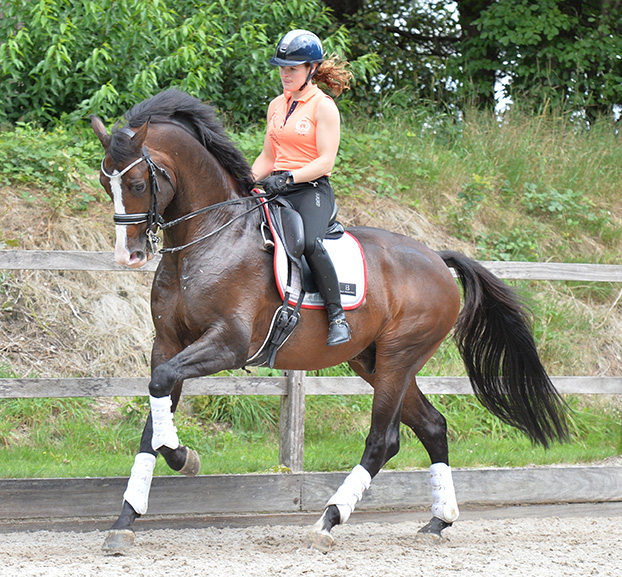
Johan tells us:
That’s a good photo, the horse is forward, it’s swinging and it’s good uphill. The neck is in the right position.
more follows
Jennifer is riding a big working pirouette…
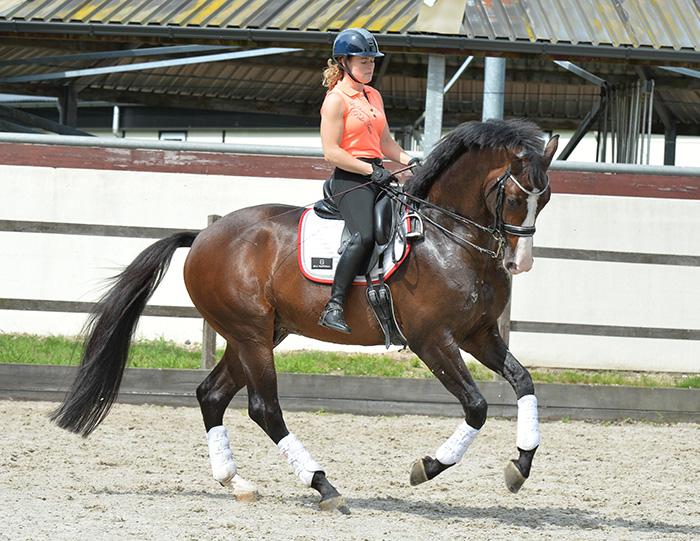
“Now you are training from behind, now you have the connection from the body to the bit. Now you have better rhythm, now he is down in the croup and carries more weight from behind. When you are working you have to always be looking, is it time we can collect a bit? Sometimes it is after fifteen minutes, sometimes thirty minutes. Now you have a better forward connection on both reins. As you collect more, there has to be a forward tendency in every second, every stride.”
“Now let him stretch a little bit more…”
Time to practice the changes and Johan is asking Jennifer to get the shoulders out of the way: “Move the shoulder right for left change, left rein soft, change. Move the shoulder left for the right change. Make more control of the shoulders.”
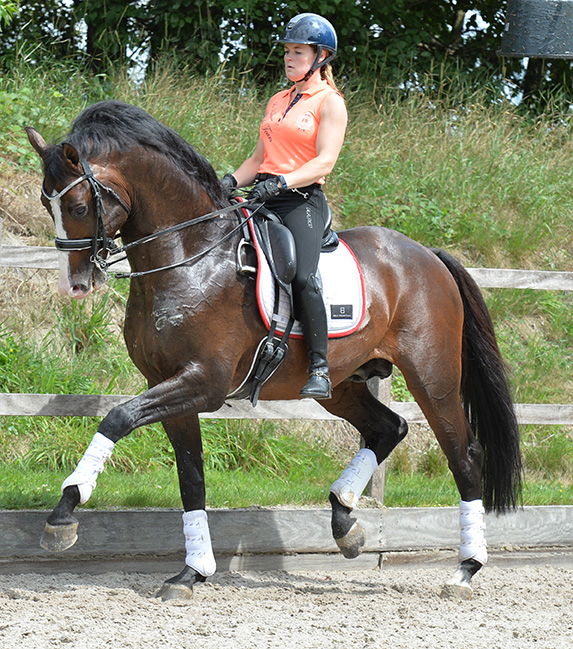
Johan tells us:
In this trot there is a lot of impulsion and the horse is good in the neck, longer in the neck, and he can use his hind legs in a better way, and that gives more impulsion and more uphill bending and tendency.
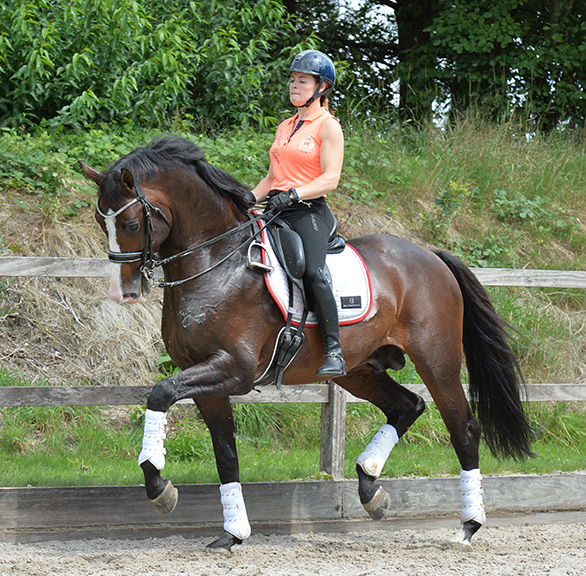
This is more collected trot. The horse is in a real balance because his right front leg is exactly in the vertical. He is good in the neck and the poll position. He can use his whole body, and there is a bending from behind so he can develop more self carriage.
It is passage time, and Johan is warning Jennifer not to ask too much:
“Look for short moments. The first five steps are the best, then stop, so he learns. Some months ago, he was too uneven, too tense in this work, so we ask more rhythm and balance before we ask for piaffe steps.”
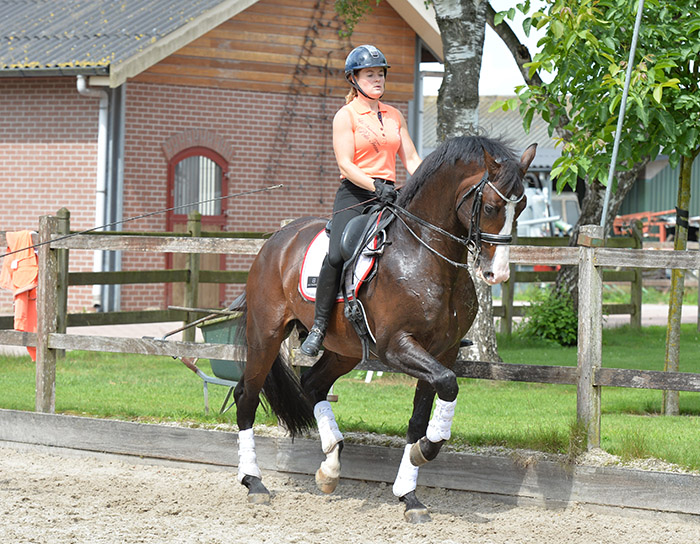
Johan tells us:
In this picture, we see a lot of strength and a good bending in the legs. The front leg is exactly lifted to level with the opposite half cannon bone, and the left hind leg is lifted ten centimetres. Good lift behind, and he is also in a good balance and the neck is uphill and good in contact. That’s a good first beginning of passage.
But Ferrero shows that he has learnt the lesson well:
“Jennifer says that the feeling this horse gives is so electric, so fine-tuned, that she says, this is my best one ever.”
Some people have the idea that it is never correct, never classical, for the horse’s nose to go behind the vertical – but you obviously don’t believe this…
“It is better to keep the nose more on the vertical then there is less chance that you make big mistakes. But if the nose comes five centimetres behind the vertical and there is a real contact and there is a real forward in the horse, and he is using his hindlegs and his body well – then there is no problem. But behind the vertical with too much pulling on the reins, then it is a big disaster.”
You always say to Jen, Let the neck fall down – fall down, not pulled down?
“When the horse is really forward, when the horse is really listening to your legs, when the horse accepts the bit and accepts the contact, then when you give a little bit more rein, the horse falls down with his neck, so much as your hands go forward. When the neck falls down from out of the wither, then you have more muscles at work in the back, and in the loins. But when the neck comes up from out of the wither and there is a bend in the 3rd, 4th, 5th vertebrae, then it is not good. We want the horse to fall down in the neck, completely, and out of the wither, and then you see a topline which is horizontal, and that’s what you want – so he uses his neck, out of the wither, in a forward direction, then he can swing / wave in his back muscles and the loins.”
It is a scene that is played out day after day in the school at Elspeet, a scene that could teach the dressage world so much about what the classical principles really look like – hopefully the series of articles we have made with Johan and Jen, give you the opportunity to share Johan’s wisdom, and enjoy Jen’s riding…




